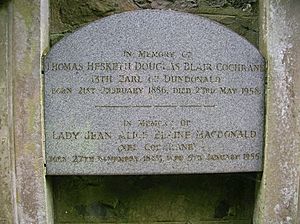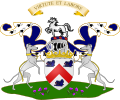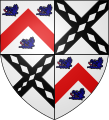Earl of Dundonald facts for kids
Quick facts for kids Earldom of Dundonald |
|
|---|---|
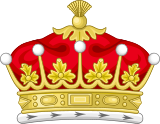 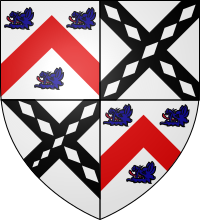 |
|
| Creation date | 1669 |
| Monarch | James II of England |
| Peerage | Peerage of Scotland |
| First holder | William Cochrane, 1st Earl of Dundonald |
| Present holder | Iain Cochrane, 15th Earl of Dundonald |
| Heir presumptive | Archibald Cochrane, Lord Cochrane |
| Subsidiary titles | Lord Cochrane of Paseley and Ochiltrie Lord Cochrane of Dundonald |
| Status | Extant |
| Seat(s) | Lochnell Castle Beacon Hall |
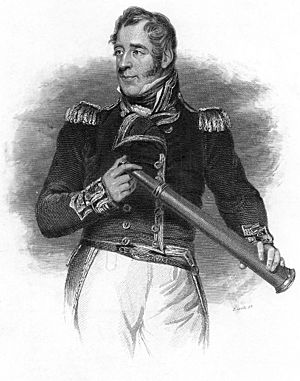
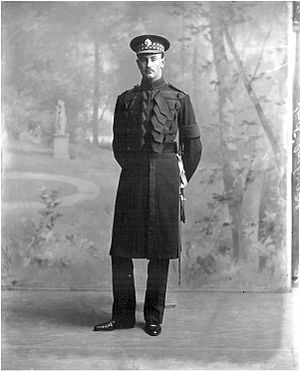
The Earl of Dundonald is an important title in the Peerage of Scotland. It was created in 1669 for a Scottish soldier and politician named William Cochrane. He was already known as the 1st Lord Cochrane of Dundonald. Along with the Earldom, he also received the title of Lord Cochrane of Paisley and Ochiltree. These titles were meant to be passed down through his family, usually to his male heirs.
Contents
Who Were the Earls of Dundonald?
The first Earl, William Cochrane, passed away in 1685. His grandson, John Cochrane, became the second Earl. He was a member of the Scottish Privy Council, a group of advisors to the monarch.
Early Earls: A Quick Look
- The 2nd Earl's son, William Cochrane, became the third Earl. He died young and without marrying.
- His younger brother, John Cochrane, then became the fourth Earl. He served in the House of Lords as a Scottish Representative Peer.
- The fifth Earl, William Cochrane, was John's son. He also died unmarried at a young age.
After the fifth Earl, the title went to his first cousin once removed, Thomas Cochrane, who became the sixth Earl. His son, William Cochrane, became the seventh Earl. This Earl was a soldier and sadly died in battle during the Seven Years' War in 1758.
Notable Earls and Their Contributions
When the seventh Earl died, the title went to another relative, Thomas Cochrane, who became the eighth Earl. Before becoming an Earl, he was a Member of Parliament.
The ninth Earl was Archibald Cochrane. He was a clever scientist and inventor. One of his most important inventions was a way to extract coal tar from coal. This invention later helped engineer William Murdoch create gas lighting in the 1790s. Even though his inventions were important, the 9th Earl faced financial difficulties and lost his family's estates.
The Famous 10th Earl
The tenth Earl was Thomas Cochrane. He was a very famous naval commander who fought bravely in the Napoleonic Wars. He was known for his daring actions at sea. His adventures even inspired fictional characters like Horatio Hornblower and Jack Aubrey in popular books!
After some challenges in his career, he went abroad and led the navies of Chile, Peru, Brazil, and Greece. He was highly respected for his leadership. In Brazil, he was even given the special title of Marquess of Maranhão by Emperor Pedro I. Later, he was welcomed back into the Royal Navy.
Later Earls and Their Legacies
- The eleventh Earl, Thomas Cochrane, also served as a Scottish Representative Peer in the House of Lords.
- His son, Douglas Cochrane, became the twelfth Earl. He was a high-ranking officer in the British Army and also a Scottish Representative Peer. He famously encouraged Canadians to stay loyal to the British Empire.
- The thirteenth Earl, Thomas Hesketh Cochrane, was also a Scottish Representative Peer. He never married.
- His nephew, Iain Douglas Cochrane, became the fourteenth Earl. He was a major in the Black Watch regiment.
Today, the title is held by Ian Alexander Cochrane, the fifteenth Earl, who inherited it in 1986. His eldest son, Archibald Iain Thomas Blair Cochrane, is the current heir.
Other Important Cochrans
Many other members of the Cochrane family have achieved great things:
- Sir Alexander Cochrane, an admiral in the Royal Navy.
- His son, Sir Thomas John Cochrane, also a naval commander and Governor of Newfoundland.
- Alexander Cochrane-Baillie, a politician who became Baron Lamington.
- John Dundas Cochrane, an explorer and traveler.
- Thomas Cochrane, a politician who became Baron Cochrane of Cults.
Where Does the Name Come From?
The Earldom is named after Dundonald, a place in Scotland. You can learn more about it by looking up Dundonald Castle. The Earl of Dundonald is also the chief of Clan Cochrane, a Scottish clan.
The family's main homes are Lochnell Castle in Argyll and Bute, and Beacon Hall in Kent.
List of Earls of Dundonald (1669)
- William Cochrane, 1st Earl of Dundonald (died 1685)
- John Cochrane, 2nd Earl of Dundonald (around 1660–1690)
- William Cochrane, 3rd Earl of Dundonald (1686–1705)
- John Cochrane, 4th Earl of Dundonald (1687–1720)
- William Cochrane, 5th Earl of Dundonald (1708–1725)
- Thomas Cochrane, 6th Earl of Dundonald (1702–1737)
- William Cochrane, 7th Earl of Dundonald (1729–1758)
- Thomas Cochrane, 8th Earl of Dundonald (1691–1778)
- Archibald Cochrane, 9th Earl of Dundonald (1749–1831)
- Thomas Cochrane, 10th Earl of Dundonald, Marquess of Maranhão (1775–1860)
- Thomas Barnes Cochrane, 11th Earl of Dundonald (1814–1885)
- Douglas Mackinnon Baillie Hamilton Cochrane, 12th Earl of Dundonald (1852–1935)
- Thomas Hesketh Douglas Blair Cochrane, 13th Earl of Dundonald (1886–1958)
- Iain Douglas Leonard Cochrane, 14th Earl of Dundonald (1918–1986)
- Iain Alexander Douglas Blair Cochrane, 15th Earl of Dundonald (born 1961)
Images for kids
See also
- Auchans Castle, Ayrshire
- Baron Cochrane of Cults
- Baron Lamington
- Clan Cochrane
- Cochrane (surname)
- Dundonald, South Ayrshire


